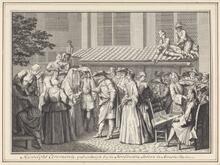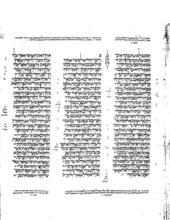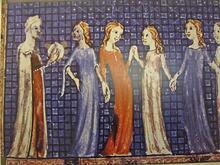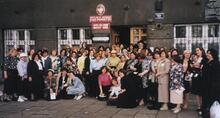Nature of Women
The Talmud describes women as a “nation unto themselves,” and rabbinic literature is replete with implications concerning the respective natures of men and women. Often the portrayals are paradoxical, citing opinions that describe seemingly opposite traits. The rabbis extrapolated from their views of women’s and men’s nature to prescribe appropriate roles for women and men in marriage and society. The broader reality, however, often balanced a narrow reading of the text; the exceptions challenge the blanket rabbinic statements that view the nature of women as an idealized, static entity and reflect female behavior and cultural patterns in different Jewish communities. Contemporary Jewish women have many models to choose from when exploring the nature of women over the centuries.
Paradoxical Portrayals of Women
The Lit. "teaching," "study," or "learning." A compilation of the commentary and discussions of the amora'im on the Mishnah. When not specified, "Talmud" refers to the Babylonian Talmud.Talmud describes women as a “nation unto themselves” (BT SabbathShabbat 62a), and rabbinic literature is replete with implications concerning the differences in the respective natures of men and women. Often the portrayals are paradoxical, citing opinions that describe seemingly opposite traits. Thus, women were given greater understanding (BT Menstruation; the menstruant woman; ritual status of the menstruant woman.Niddah 45b); women are light minded (BT Kiddushin 80b). Women are more familiar with handling guests (BT Berakhot 10b); women are stingier with their guests (BT Bava Mezia 87a). Women are thieves (Genesis Rabbah 45:5); it is not the way of women to steal (Nahmanides, Numbers 5:6). Women are lazy (Genesis Rabbah 45); women do not sit around idly (JT Ketubbot 5:6).
Several sweeping statements address the general tendencies of women to be compassionate (BT Lit. "scroll." Designation of the five scrolls of the Bible (Ruth, Song of Songs, Lamentations, Ecclesiastes, Esther). The Scroll of Esther is read on Purim from a parchment scroll.Megillah 14b), holy and pure (Sifrei, Deuteronomy, Ki Tezei), talkative (BT Kiddushin 49b), and given to tears (BT Bava Mezia 59a). Women are less easily appeased than men (BT Niddah 31b) and a woman is an unfinished vessel until she enters a relationship with a man who will be her husband and “creator” (BT Sanhedrin 22b). A woman is comfortable in her mother’s house (Genesis Rabbah 60:7) and content only in her husband’s house (Ruth Rabbah 2:16). Women’s needs differ from those of men, so when they are commanded to rejoice for the holidays they celebrate with new clothing while men drink wine (BT Pesahim 109a). Detailed Shabbat laws address how to deal with a woman’s propensity to wear jewelry and perfume.
The rabbis offered comparisons between women and men which often served as the rationale behind practical legislation. When the Jews left Egypt, they were not greeted by the neighboring nations with food and water. Since it was less in the nature of women to venture out to greet travelers, whereas men were expected to be more assertive (BT Yevamot 76b), a law was codified that prohibited the males of the Ammonites and Moabites from converting to join the Jewish people, while the females were permitted to convert. Even though the Torah she-bi-khetav: Lit. "the written Torah." The Bible; the Pentateuch; Tanakh (the Pentateuch, Prophets and Hagiographia)Torah describes how in the evening women would draw water from the well (Genesis 24:11), when Moses went to Midian he expected the men to draw the water and the women to feed the herd (Exodus Rabbah 1:32). Naked females could sit on the floor and still knead their dough with a blessing since their anatomy allows them to cover themselves, whereas naked males are forbidden to do so (BT Berakhot 24a).
Since women feel shame more profoundly than men, females are given priority when their cases are awaiting a court appearance (Moses ben Maimon (Rambam), b. Spain, 1138Maimonides, Sanhedrin 21:6) It is more difficult for girls to beg for charity than for boys, so if the inherited estate is inadequate, the daughters are provided for and the sons go out to beg. However, a woman who is widowed is supported before her daughter, who can be sent to beg when necessary (Bava Batra 139b). Women’s sense of embarrassment was reflected in capital punishment laws: a male could be stoned naked or have his body hung in public for a short time; a female was stoned clothed and not hung out for all to see (Sanhedrin 45a–b). An elaborate series of Halakhic decisions written by rabbinic authories in response to questions posed to them.responsa concentrate on maintaining female modesty through menstrual restrictions, head covering, and appropriate dress.
A Woman’s Role
When it deals with marriage laws, the Bible describes a man taking a woman (and not vice versa) since it is the nature of a man to search for a woman and not a woman’s nature to go after a man (BT Kiddushin 2b). In the area of sexuality, it is a married women’s right to receive sexual pleasure from her husband. Yet the rabbis felt that men suffer more from sexual deprivation than do women. They learned this by looking at street corners, observing that there were more men soliciting sex from women than women propositioning men (BT Ketubbot 64b). Therefore, in a marriage where either spouse “rebels” and refuses to fulfill his or her sexual obligations to the partner, the wife is penalized by having to pay a higher tax than the husband for the same infraction, since it is the nature of men to be hurt more. Long before Freud, the Talmud acknowledged that a man’s sexual drive is externally visible, while a woman’s sexuality is more covert (ibid). A man articulates his sexual desire but a woman keeps her demands in her heart (BT Eruvin 100b). Consequently, it is the nature of women to be able to examine their bodies without being sexually stimulated, while men are mostly unable to do so (BT Niddah 13a).
The biblical story of creation and the curses imposed on Adam and Eve have become a prototype for male and female differences. On the one hand, God’s formation of Eve from Adam’s side (zela) sends all males on a quintessential search for wholeness, found only in marriage and the unity of husband and wife (BT Yevamot 63a, BT Niddah 31b). On the other hand, Eve’s role as a helpmate, her designation as the mother of all life and the hierarchical basis of her relationship to Adam (Genesis 3) have been used by the rabbis as proof of the distinctions between male and female roles. The biblical punishments of childbirth and working the land further entrench a division of labor. Two versions of these separate spheres appear in the Talmud: women handle the household; men deal with worldly matters. Alternatively, women deal with worldly matters and men handle the heavenly-related affairs (BT Bava Mezia 59a).
The Bible uses different language when describing the giving of the Torah at Sinai: “speak” to the women—in a soft tone, and “talk” to the men—in a harsh tone (Mekhilta, Exodus 19:3). The women were asked before the men because it is the nature of men to follow the opinion of women (Pirkei d’Rabbi Eliezer 41). The women refused to contribute their jewelry to the golden calf, thus exhibiting greater faith than the men (Pirkei d’Rabbi Eliezer 45) and the women loved the land of Israel more than the men, prompting one commentary to bemoan the fact that Moses sent male spies and not female ones (Kli Yakar). The daughters of Zelophehad, who demonstrated their love of the land by requesting a portion, epitomized the constructive nature of the women of that generation who built up what the men had destroyed (Numbers Rabbah 21:10).
Several commentaries have analyzed women’s exemption from some time-limited positive commandments. Abudarham (fourteenth century) explained that a wife was subservient to her husband in order to meet his needs and their marriage would suffer if her husband demanded something from her while she was performing God’s commands. Other authorities have said that females were freed from time-bound laws to enable them to use their nurturing nature to manage the home and children without time constraints. The nature of a woman to find all her honor within (Psalms 45:14) strengthened the concept that women controlled the private sphere while men dominated public life.
God’s directive to Adam and Eve to fill the earth and conquer it was interpreted by the rabbis to refer to males only, since it is the way of men to conquer and not the way of women (BT Yevamot 65b). Women’s non-military nature found support in the A type of non-halakhic literary activitiy of the Rabbis for interpreting non-legal material according to special principles of interpretation (hermeneutical rules).Midrash on the biblical law forbidding cross-gender dressing, which could be seen as prohibiting women from donning weapons and going off to war (Sifrei, Deuteronomy, Ki Tezei). Yet in mandatory battles all Jews are sent off to fight and even a bride leaves her canopy to join the war effort (BT Suspected adulteressSotah 44b). The fact that women’s exemption could be revoked may signify women’s flexible nature, which enables them to fight when necessary. However, the rabbinic comment may have been an indication of contemporary social norms, which generally excluded women from participating in military conquest.
Beyond the Bible
The broader reality often balanced a narrow reading of the text. Historically, individual women did prophesy (BT Megillah 14a), judge (Deborah), study the law (Beruryah), fight (Jael), testify (Shulhan Arukh Even ha-Ezer 17:3), voluntarily perform commandments (Michal), and initiate sexual relations with their husbands (Leah). The exceptions challenge the blanket rabbinic statements that view the nature of women as an idealized, static entity. Perhaps they provide a realistic assessment of changing conditions, reflecting female behavior and cultural patterns in different Jewish communities.
Women left their houses to shop and sell their wares despite Maimonides’s declaration that nothing was lovelier for a woman than sitting in the corner of her home. The Magen Avraham (Abraham Abele ben Hayyim ha-Levi Gombiner, c. 1637–1683) claims that since women have taken upon themselves to count the days of the omer, they are now equal to men in their obligation. Despite their biblical exemption, for centuries women have committed themselves to hearing the Ram's horn blown during the month before and the two days of Rosh Ha-Shanah, and at the conclusion of Yom Kippur. shofar, perhaps signaling a change in their status regarding time-limited commandments. Females might reason differently from males, but certainly modern Jewish women have mastered Torah scholarship, which for centuries was the exclusive domain of Jewish men.
Contemporary Jewish women have many models to choose from when exploring the nature of women over the centuries. New research in both the Jewish and secular worlds has led to a composite of female identities by acknowledging that the nature of women was never a singular entity. Greater options for women plus progress in research have resulted in a multiplicity of voices, ranging from the early feminist activists who saw no difference in the natures of women and men other than basic biology, to the more recent views that address genetic, biochemical, spiritual, sexual and psychological distinctions. Interest in how females learn and think, how they relate to one another and how they are treated by those around them continues to expand, stimulating renewed debate and ongoing discovery.
Berkovits, Eliezer. Jewish Women in Time and Torah. Hoboken: 1990.
Biale, Rachel. Women and Jewish Law. New York: 1984.
Brayer, Menahem. The Jewish Woman in Rabbinic Literature (2 vols). Hoboken: 1986.
Ellinson, Getsel. Women and the Mitzvot (3 vols). Jerusalem, 1986.
Gilligan, Carol. In a Different Voice. Cambridge: 1982, 1993.
Halpern, Micah and Chana Safrai, eds. Jewish Legal Writings by Women. Jerusalem: 1998.
Kaufman, Michael. The Woman in Jewish Law and Tradition. Northvale: 1993.
Rudavsky, T. M., ed. Gender and Judaism. New York: 1995.
Wolowosky, Joel. Women, Jewish Law and Modernity. Hoboken: 1997.






